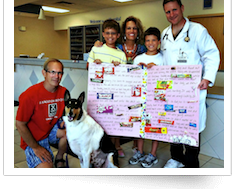Anaphylactic Shock
Written by: Tia Cavender, 1st Year Veterinary Student • 2018 Scholar
 Lola is a 5 year old spayed female Boston Terrier mix. She was brought into IVS after she was found outside collapsed at the bottom of the steps following a noise. Lola was laterally recumbent in a semicomatose state and was leaking bloody diarrhea upon presentation to IVS.
Lola is a 5 year old spayed female Boston Terrier mix. She was brought into IVS after she was found outside collapsed at the bottom of the steps following a noise. Lola was laterally recumbent in a semicomatose state and was leaking bloody diarrhea upon presentation to IVS.
Physical Exam Findings
- Dark mucous membranes
Mucous membrane (gum) color reflects blood perfusion. Healthy gums are pink in color. Lola’s gums were a dark muddy pink, indicating pooling of blood. - Delayed capillary refill time
Capillary refill time (CRT) is the time it takes for color to return to the gums after the pressure applied by something, such as a finger, is released. Normal capillary refill time is less than two seconds. Lola’s initial capillary refill time was four seconds, indicating poor perfusion. - Hemorrhagic (bloody) diarrhea
Indicates injury to tissue lining the intestines. - Semicomatose state
Upon presentation Lola was laterally recumbent with a diminished response to stimuli. - Hypothermic
Normal body temperature for dogs is between 99.5-102.5 degrees Fahrenheit. Lola’s initial temperature was below normal at 95.5 degrees.
In order to generate a definitive diagnosis and assess organ damage, bloodwork was run on Lola. Significant findings are listed below:
Diagnostic Results
- Hemoconcentration
Hemoconcentration is an increase in the concentration of cells and solids present within the bloodstream as a result of decreased plasma volume. Lola had the following elevated values:- Red blood cell count =concentration of red blood cells
- Hemoglobin = oxygen carrying protein in red blood cells
- Hematocrit = proportion of red blood cells to fluid in blood
- Azotemia
Azotemia is a condition in which the blood contains abnormally high levels of nitrogen containing compounds such as urea or creatinine. These nitrogenous waste products are normally filtered and excreted from the bloodstream by the kidneys. Elevated levels of BUN (blood nitrogen urea) and creatinine in the blood indicate kidney damage. In Lola’s case the azotemia was likely caused by decreased blood flow to the kidneys since she displayed other signs of decreased blood perfusion (delayed CRT, dark mucous membranes). - Hyperphosphatemia (elevated blood phosphorous)
- Excess phosphorous is normally removed from the blood stream by the kidneys. Elevated blood phosphorous can indicated kidney damage.
- Hypoglycemia (low blood glucose)
Low blood sugar can occur in certain breeds of puppies and kittens if they aren’t eating well, but this is not a common finding in adults. Hypoglycemia can occur in sepsis, anaphylactic shock and administration of too much insulin in diabetic patients. - High ALT (alanine aminotransferase)
Alanine aminotransferase is an enzyme produced by the liver. It can be leaked into the bloodstream following liver damage due to injury such as decreased blood perfusion.
Diagnosis
 Anaphylactic shock- a severe condition in which the body initiates a heightened inflammatory response to an allergen which results in extensive dilation of blood vessels and increased vascular permeability, decreasing blood perfusion and oxygen delivery to tissues. Anaphylaxis may be triggered by food, drugs, or insect stings like bees or wasps.
Anaphylactic shock- a severe condition in which the body initiates a heightened inflammatory response to an allergen which results in extensive dilation of blood vessels and increased vascular permeability, decreasing blood perfusion and oxygen delivery to tissues. Anaphylaxis may be triggered by food, drugs, or insect stings like bees or wasps.
- Intravenous (IV) fluid with dextrose
IV fluids were given to increase plasma volume and prevent cardiovascular collapse due to extensive vasodilation. Dextrose is a sugar which was added to increase her blood sugar levels. The fluids were changed to a balanced electrolyte solution without dextrose once her blood sugar stabilized.
Treatment
- Epinephrine
Epinephrine was given to induce vasoconstriction. By constricting blood vessels, epinephrine increases blood pressure and improves circulation in shock patients. - Dexamethasone sodium phosphate (Dex SP)
Dex SP is a steroid which was given to suppress the inflammatory immune response initiated during the anaphylactic reaction. - Cerenia
Cerenia is an anti-nausea medication given to Lola to help prevent vomiting. - Metronidazole
Metronidazole is an antibiotic which also has anti-inflammatory effects in the bowel. This was given to prevent against a secondary bacterial infection and to help with Lola’s bloody diarrhea. - Diphenhydramine
Diphenhydramine is an anti-histamine used to suppress the immune response to the allergen and help with any pain or itching. - Vetstarch
Vetstarch is a type of intravenous fluid therapy used to increase plasma volume. It was given to Lola when IV dextrose was backed off in an effort to raise her blood pressure. - Prednisone
Prednisone is also a steroid used to suppress the inflammatory response. It was given after the Dex SP wore off and is a less potent immunosuppressant.
Lola was hospitalized at IVS for 24 hours for monitoring and IV fluids. She returned home where she made a full recovery. Today Lola is back to her happy normal self, according to a recent update from her owners.
 Within an hour of receiving an epinephrine injection and beginning IV fluids with dextrose, Lola’s blood perfusion began to improve. Her mucous membranes returned to a healthy pink and her CRT was less than two seconds. Uticaria, or hives, began to develop on her skin, confirming her diagnosis of anaphylactic shock. These skin markings are generated by an inflammatory response to the toxin in which the release of histamine and other substances cause fluid to accumulate under the skin.
Within an hour of receiving an epinephrine injection and beginning IV fluids with dextrose, Lola’s blood perfusion began to improve. Her mucous membranes returned to a healthy pink and her CRT was less than two seconds. Uticaria, or hives, began to develop on her skin, confirming her diagnosis of anaphylactic shock. These skin markings are generated by an inflammatory response to the toxin in which the release of histamine and other substances cause fluid to accumulate under the skin.
Resources
- Basile, David P., Melissa D. Anderson, and Timothy A. Sutton. “Pathophysiology of Acute Kidney Injury.” Comprehensive Physiology 2.2 (2012): 1303–1353. PMC. Web. 18 July 2018.
- Bee picture. [Digital image]. Retrieved July 18, 2018, from https://usalivebeeremoval.com/articles/high-rated-bee-removal-company/.
- Hives picture. [Digital image]. Retrieved July 18, 2018, from http://happypitbull.blogspot.com/2010/11/hives-and-staph-and-allergies-oh-my.html
- Kanczkowski, Waldemar, Mariko Sue, and Stefan R. Bornstein. “Adrenal Gland Microenvironment and Its Involvement in the Regulation of Stress-Induced Hormone Secretion during Sepsis.” Frontiers in Endocrinology 7 (2016): 156. PMC. Web. 18 July 2018.
- Lyons, Jennifer L, and Jordan R Scherk. “Anaphylactic Shock: How to Effectively Diagnose and Treat.” Today's Veterinary Practice, 22 May 2018. Retrieved July 18, 2018, from https://www.todaysveterinarypractice.com/anaphylactic-shock-effectively-diagnose-treat/.
- Plumb, D.C. (2005). Plumb’s Veterinary Drug Handbook (8th ed.). Wiley-Blackwell.




